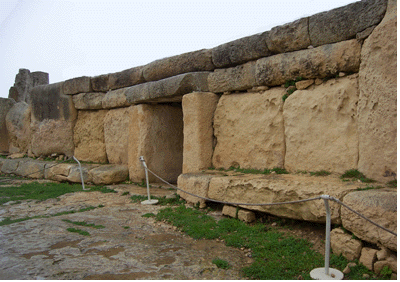...Best of Sicily presents... Best of Sicily Magazine. ... Dedicated to Sicilian art, culture, history, people, places and all things Sicilian. |
by Carlo Trabia | |||
Magazine Index Best of Sicily Arts & Culture Fashion Food & Wine History & Society About Us Travel Faqs Contact Map of Sicily
|
In Malta. Yes, the earliest known inhabitants of Malta arrived from Sicily some time before 5,200 BC, and they quite literally laid the foundations of a culture which in many ways seems to have been far more sophisticated than anything else in Europe or the Mediterranean region at that time. Incidentally, they also invented the earliest rudimentary wheels, initially rounded stones which fit easily into the semicircular wedges carved into the bases of large rectangular megaliths, thus facilitating the rolling transport of these huge stones. Not only did they build circular megalithic temples coordinated (like Stonehenge) to the position of the sun at key points during the year, these neolithic Maltese left behind realistic sculptures of the human figure in a range of sizes, from small clay figurines to life-size statues carved of the native limestone. Some are detailed enough to give us an idea of the dresses the women wore. Many of these realistic sculptures date to around 3,600 BC. The Maltese temple builders had frequent contact with Sicily, as well as Lipari and Pantelleria, where they obtained flint, obsidian and red ochre.
The society of the temple builders appears to have thrived in Malta into the early Bronze Age (which began around 2,500 BC), but their numbers seem to have diminished considerably during this period. The Phoenicians arrived around 750 BC and re-colonised the Maltese islands. It is noteworthy that nothing similar to the Maltese temples has been discovered in Sicily itself, even in the south-eastern region around Stentinello. The Sicanian temple at Cefalù is much more recent. It appears as if the Maltese temple-building culture represented a singular moment in the development of neolithic culture and technology in a relatively isolated environment. So far as we know, Sicily's own Proto-Sicanians developed nothing nearly so sophisticated, and the later Sicanians, about whom precious little is known, were doubtless influenced by other Mediterranean cultures to some degree. Another point not to be overlooked is that before people began building actual stone structures they lived in caves or perhaps in very primitive wooden shelters. This was true of farmers as well as hunter-gatherers. The construction of megalithic and subterranean habitats, whether for worship, burial or habitation, represented a quantum leap in human development because it meant that we could finally begin to control our environment. That this was accomplished without the use of metals or other technology is all the more remarkable. The intellectual process behind such development was, for its time, every bit as important as our modern inventions. It required ingenuity, planning and, most of all, cooperation. About the Author: Architect Carlo Trabia has written for this publication and others. | ||
Top of Page |
 Sometime around 4,000
BC (BCE), ancient Sicilians began building Europe's oldest free-standing
monumental structures, which are among the oldest such constructions in
the world (the temple at Göbekli Tepe in Turkey is older). These megalithic
temples, built by a neolithic people culturally
similar to the society of the Stentinello culture near Syracuse, are known
by such names as Zebbug, Gantija, Mnajdra, Hagar Qim and Tarxien. These
temples pre-date by millennia the Egyptian pyramids and such structures
as Stonehenge and similar megalithic monuments in north-western Europe.
We know little of these earliest Sicilians, though they were probably part
of an influx of neolithic farmers who arrived in the central Mediterranean
from the east sometime before 10,000 BC, identified genetically with Y Haplogroup
J2 (M172), and some of their pottery has been dated to around 5,200 BC.
One might speculate that these neolithic builders were the ancestors of
the Proto-
Sometime around 4,000
BC (BCE), ancient Sicilians began building Europe's oldest free-standing
monumental structures, which are among the oldest such constructions in
the world (the temple at Göbekli Tepe in Turkey is older). These megalithic
temples, built by a neolithic people culturally
similar to the society of the Stentinello culture near Syracuse, are known
by such names as Zebbug, Gantija, Mnajdra, Hagar Qim and Tarxien. These
temples pre-date by millennia the Egyptian pyramids and such structures
as Stonehenge and similar megalithic monuments in north-western Europe.
We know little of these earliest Sicilians, though they were probably part
of an influx of neolithic farmers who arrived in the central Mediterranean
from the east sometime before 10,000 BC, identified genetically with Y Haplogroup
J2 (M172), and some of their pottery has been dated to around 5,200 BC.
One might speculate that these neolithic builders were the ancestors of
the Proto- One of the most curious constructions is the underground burial complex
outside Valletta known as the Hal Saflieni Hypogeum. This is far more than
a catacomb or decorated cavern. It is, instead, an expansive series of interconnected
chambers carved deep into the limestone in imitation of the trilithons and
other features of the temples present above ground. (The trilithon entrance
of the Hagar Qim temple is shown here.) Surface construction began around
3,800 BC and continued for centuries. The hypogeum is truly unique. There
is nothing quite like it anyplace else on earth. In Siracusa, a much smaller hypogeum
houses the
One of the most curious constructions is the underground burial complex
outside Valletta known as the Hal Saflieni Hypogeum. This is far more than
a catacomb or decorated cavern. It is, instead, an expansive series of interconnected
chambers carved deep into the limestone in imitation of the trilithons and
other features of the temples present above ground. (The trilithon entrance
of the Hagar Qim temple is shown here.) Surface construction began around
3,800 BC and continued for centuries. The hypogeum is truly unique. There
is nothing quite like it anyplace else on earth. In Siracusa, a much smaller hypogeum
houses the